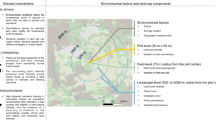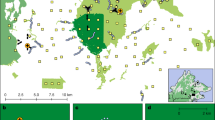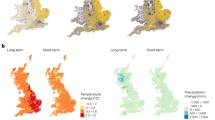Abstract
The conversion of tropical rainforest to agricultural systems such as oil palm alters biodiversity across a large range of interacting taxa and trophic levels. Yet, it remains unclear how direct and cascading effects of land-use change simultaneously drive ecological shifts. Combining data from a multi-taxon research initiative in Sumatra, Indonesia, we show that direct and cascading land-use effects alter biomass and species richness of taxa across trophic levels ranging from microorganisms to birds. Tropical land use resulted in increases in biomass and species richness via bottom-up cascading effects, but reductions via direct effects. When considering direct and cascading effects together, land use was found to reduce biomass and species richness, with increasing magnitude at higher trophic levels. Our analyses disentangle the multifaceted effects of land-use change on tropical ecosystems, revealing that biotic interactions on broad taxonomic scales influence the ecological outcome of anthropogenic perturbations to natural ecosystems.
This is a preview of subscription content, access via your institution
Access options
Access Nature and 54 other Nature Portfolio journals
Get Nature+, our best-value online-access subscription
$29.99 / 30 days
cancel any time
Subscribe to this journal
Receive 12 digital issues and online access to articles
$119.00 per year
only $9.92 per issue
Buy this article
- Purchase on Springer Link
- Instant access to full article PDF
Prices may be subject to local taxes which are calculated during checkout




Similar content being viewed by others
References
Laurance, W. F., Sayer, J. & Cassman, K. G. Agricultural expansion and its impacts on tropical nature. Trends Ecol. Evol. 29, 107–116 (2014).
Foley, J. A. et al. Global consequences of land use. Science 309, 570–574 (2005).
Newbold, T. et al. Global effects of land use on local terrestrial biodiversity. Nature 520, 45–50 (2015).
Basset, Y. et al. Arthropod diversity in a tropical forest. Science 338, 1481–1484 (2012).
Wilcove, D. S., Giam, X., Edwards, D. P., Fisher, B. & Koh, L. P. Navjot’s nightmare revisited: logging, agriculture, and biodiversity in Southeast Asia. Trends Ecol. Evol. 28, 531–540 (2013).
Fitzherbert, E. B. et al. How will oil palm expansion affect biodiversity? Trends Ecol. Evol. 23, 538–545 (2008).
Li, H., Aide, T. M., Ma, Y., Liu, W. & Cao, M. Demand for rubber is causing the loss of high diversity rain forest in SW China. Biodivers. Conserv. 16, 1731–1745 (2007).
Barnes, A. D. et al. Consequences of tropical land use for multitrophic biodiversity and ecosystem functioning. Nat. Commun. 5, 5351 (2014).
Gibson, L. et al. Primary forests are irreplaceable for sustaining tropical biodiversity. Nature 478, 378–381 (2011).
Tylianakis, J. M., Didham, R. K., Bascompte, J. & Wardle, D. A. Global change and species interactions in terrestrial ecosystems. Ecol. Lett. 11, 1351–1363 (2008).
Tscharntke, T. et al. Landscape moderation of biodiversity patterns and processes - eight hypotheses. Biol. Rev. 87, 661–685 (2012).
Gardner, T. A. et al. Prospects for tropical forest biodiversity in a human-modified world. Ecol. Lett. 12, 561–582 (2009).
Denno, R. F. et al. Bottom-up forces mediate natural-enemy impact in a phytophagous insect community. Ecology 83, 1443–1458 (2002).
Scherber, C. et al. Bottom-up effects of plant diversity on multitrophic interactions in a biodiversity experiment. Nature 468, 553–556 (2010).
Borer, E. T., Seabloom, E. W., Tilman, D. & Novotny, V. Plant diversity controls arthropod biomass and temporal stability. Ecol. Lett. 15, 1457–1464 (2012).
Wootton, J. T. The nature and consequences of indirect effects in ecological communities. Annu. Rev. Ecol. Syst. 25, 443–466 (1994).
Grace, J. B. Structural Equation Modeling and Natural Systems (Cambridge Univ. Press, New York, 2006).
Shipley, B. Confirmatory path analysis in a generalized multilevel context. Ecology 90, 363–368 (2009).
Allen, K., Corre, M. D., Tjoa, A. & Veldkamp, E. Soil nitrogen-cycling responses to conversion of lowland forests to oil palm and rubber plantations in Sumatra, Indonesia. PLoS ONE 10, e0133325 (2015).
Hautier, Y., Niklaus, P. A. & Hector, A. Competition for light causes plant biodiversity loss after eutrophication. Science 324, 636–638 (2009).
Tripathi, B. M. et al. Tropical soil bacterial communities in Malaysia: pH dominates in the equatorial tropics too. Microb. Ecol. 64, 474–484 (2012).
Schneider, D. et al. Impact of lowland rainforest transformation on diversity and composition of soil prokaryotic communities in Sumatra (Indonesia). Front. Microbiol. 6, 1–12 (2015).
Krashevska, V., Klarner, B., Widyastuti, R., Maraun, M. & Scheu, S. Impact of tropical lowland rainforest conversion into rubber and oil palm plantations on soil microbial communities. Biol. Fert. Soils 51, 697–705 (2015).
Lange, M. et al. Plant diversity increases soil microbial activity and soil carbon storage. Nat. Commun. 6, 6707 (2015).
Zak, D. R., Holmes, W. E., White, D. C., Peacock, A. D. & Tilman, D. Plant diversity, soil microbial communities, and ecosystem function: are there any links? Ecology 84, 2042–2050 (2003).
Ewers, R. M. & Didham, R. K. Confounding factors in the detection of species responses to habitat fragmentation. Biol. Rev. 81, 117–142 (2006).
Rand, T. A., Tylianakis, J. M. & Tscharntke, T. Spillover edge effects: the dispersal of agriculturally subsidized insect natural enemies into adjacent natural habitats. Ecol. Lett. 9, 603–614 (2006).
Degens, B. P., Schipper, L. A., Sparling, G. P. & Duncan, L. C. Is the microbial community in a soil with reduced catabolic diversity less resistant to stress or disturbance? Soil Biol. Biochem. 33, 1143–1153 (2001).
Wilson, E. O. & Hölldobler, B. Eusociality: origin and consequences. Proc. Natl Acad. Sci. USA 102, 13367–13371 (2005).
Hill, J. K. & Hamer, K. C. Determining impacts of habitat modification on diversity of tropical forest fauna: the importance of spatial scale. J. Appl. Ecol. 41, 744–754 (2004).
Mumme, S., Jochum, M., Brose, U., Haneda, N. F. & Barnes, A. D. Functional diversity and stability of litter-invertebrate communities following land-use change in Sumatra, Indonesia. Biol. Conserv. 191, 750–758 (2015).
Digel, C., Curtsdotter, A., Riede, J. O., Klarner, B. & Brose, U. Unravelling the complex structure of forest soil food webs: higher omnivory and more trophic levels. Oikos 123, 1157–1172 (2014).
Vijay, V., Pimm, S. L., Jenkins, C. N. & Smith, S. J. The impacts of oil palm on recent deforestation and biodiversity loss. PLoS ONE 11, e0159668 (2016).
Margono, B., Potapov, P., Turubanova, S., Stolle, F. & Hansen, M. C. Primary forest cover loss in Indonesia over 2000–2012. Nat. Clim. Change 4, 730–735 (2014).
IUSS Working Group WRB World Reference Base for Soil Resources 2006 - A Framework for International Classification, Correlation and Communication (Food and Agriculture Organization of the United Nations, Rome, 2006).
Soil Survey Staff. Keys to Soil Taxonomy, 12th ed. (USDA-Natural Resources Conservation Service, Washington DC, 2014).
Allen, K., Corre, M. D., Kurniawan, S., Utami, S. R. & Veldkamp, E. Spatial variability surpasses land-use change effects on soil biochemical properties of converted lowland landscapes in Sumatra, Indonesia. Geoderma 284, 42–50 (2016).
Lewis, S. L. et al. Concerted changes in tropical forest structure and dynamics: evidence from 50 South American long-term plots. Phil. Trans. R. Soc. Lond. B 359, 421–436 (2004).
Drescher, J. et al. Ecological and socio-economic functions across tropical land use systems after rainforest conversion. Phil. Trans. R. Soc. B 371, 20150275 (2016).
Gee, G. & Bauder, J. in Methods of Soil Analysis, Part 1 (ed. Klute, A.) 383–411 (Soil Science Society of America, Madison, WI, 1986).
Blake, G. & Hartge, K. in Methods of Soil Analysis, Part 1 (ed. Klute, A.) 363–375 (Soil Science Society of America, Madison, WI, 1986).
Chave, J. et al. Tree allometry and improved estimation of carbon stocks and balance in tropical forests. Oecologia 145, 87–99 (2005).
Wauters, J. B., Coudert, S., Grallien, E., Jonard, M. & Ponette, Q. Carbon stock in rubber tree plantations in western Ghana and Mato Grosso (Brazil). Forest Ecol. Manag. 255, 2347–2361 (2008).
Asari, N., Suratman, M. N., Jaafar, J. & Khalid, M. M. Estimation of above ground biomass for oil palm plantations using allometric equations. Int. Proc. Chem. Biol. Environ. Eng. 58, 110–114 (2013).
Schnitzer, S. A., DeWalt, S. J. & Chave, J. Censusing and measuring lianas: a quantitative comparison of the common methods. Biotropica 38, 581–591 (2006).
Niiyama, K. et al. Estimation of root biomass based on excavation of individual root systems in a primary dipterocarp forest in Pasoh Forest Reserve, Peninsular Malaysia. J. Trop. Ecol. 26, 271–284 (2010).
Syahrinudin The Potential of Oil Palm and Forest Plantations for Carbon Sequestration on Degraded Land in Indonesia (ed. Vlek, P. L. G.) (Ecology and Development Series No. 28, Cuvillier Verlag, Goettingen, 2005).
Grove, S. J. Extent and composition of dead wood in Australian lowland tropical rainforest with different management histories. Forest Ecol. Manag. 154, 35–53 (2001).
Kauffman, J. B. & Donato, D. Protocols for the Measurement, Monitoring and Reporting of Structure, Biomass and Carbon Stocks in Mangrove Forests (Center for International Forestry Research (CIFOR), Bogor, 2012).
Brookes, P. C., Landman, A., Pruden, G. & Jenkinson, D. S. Chloroform fumigation and the release of soil nitrogen: a rapid direct extraction method to measure microbial biomass nitrogen in soil. Soil Biol. Biochem. 17, 837–842 (1985).
Davidson, E. A., Eckert, R. W., Hart, S. C. & Firestone, M. K. Direct extraction of microbial biomass nitrogen from forest and grassland soils of California. Soil Biol. Biochem. 21, 773–778 (1989).
Schneider, D., Arp, G., Reimer, A., Reitner, J. & Daniel, R. Phylogenetic analysis of a microbialite-forming microbial mat from a hypersaline lake of the Kiritimati Atoll, central Pacific. PLoS ONE 8, e66662 (2013).
Caporaso, J. G. et al. QIIME allows analysis of high-throughput community sequencing data. Nat. Methods 7, 335–336 (2010).
Bragg, L., Stone, G., Imelfort, M., Hugenholtz, P. & Tyson, G. W. Fast, accurate error-correction of amplicon pyrosequences using Acacia. Nat. Methods 9, 425–426 (2012).
Edgar, R. C., Haas, B. J., Clemente, J. C., Quince, C. & Knight, R. UCHIME improves sensitivity and speed of chimera detection. Bioinformatics 27, 2194–2200 (2011).
Larsen, N. et al. The ribosomal database project. Nucleic Acids Res. 21, 3021–3023 (1993).
Quast, C. et al. The SILVA ribosomal RNA gene database project: improved data processing and web-based tools. Nucleic Acids Res. 41, D590–D596 (2012).
Wielgoss, A., Tscharntke, T., Buchori, D., Fiala, B. & Clough, Y. Temperature and a dominant dolichoderine ant species affect ant diversity in Indonesian cacao plantations. Agr. Ecosyst. Environ. 135, 253–259 (2010).
Fayle, T. M., Yusah, K. M. & Hashimoto, Y. Key to the Ant Genera of Borneo in English and Malay (2014); http://www.tomfayle.com/Key%20to%20the%20ant%20genera%20of%20Borneo%20v1%20(English-Malay).pdf
Gowing, G. & Recher, H. F. Length–weight relationships for invertebrates from forests in south-eastern New South Wales. Aust. J. Ecol. 9, 5–8 (1984).
Wilman, H. et al. EltonTraits 1.0: species-level foraging attributes of the world’s birds and mammals. Ecology 95, 2027 (2014).
R Core Team R: A Language and Environment for Statistical Computing (R Foundation for Statistical Computing, Vienna, 2015).
Swaine, M. D. Rainfall and soil fertility as factors limiting forest species distributions in Ghana. J. Ecol. 84, 419–428 (1996).
Lefcheck, J. S. piecewiseSEM: piecewise structural equation modelling in R for ecology, evolution, and systematics. Methods Ecol. Evol. 7, 573–579 (2016).
Chapin, F. S. III et al. Consequences of changing biodiversity. Nature 405, 234–242 (2000).
Nakagawa, S. & Schielzeth, H. A general and simple method for obtaining R 2 from generalized linear mixed-effects models. Methods Ecol. Evol. 4, 133–142 (2013).
Olobatuyi, M. E. A User’s Guide to Path Analysis (University Press of America, Lanham, MD, 2006).
Zuur, A. F., Ieno, E. N. & Elphick, C. S. A protocol for data exploration to avoid common statistical problems. Methods Ecol. Evol. 1, 3–14 (2010).
Byrne, B. M. Structural Equation Modeling with AMOS: Basic Concepts, Applications and Programming (Taylor and Francis, New York, 2012).
Acknowledgements
We thank R. K. Didham, J. S. Powers and C. Scherber for providing helpful comments and suggestions. We acknowledge the village leaders, local landowners, PT REKI and Bukit Duabelas National Park for granting us access and use of their properties, and thank our permit granting bodies, the Indonesian Institute of Sciences (LIPI) and the Ministry of Forestry (PHKA). We also thank our field and laboratory assistants, the rangers within the protected forest areas for assistance in the field, and D. Gunawan from the Meteorological, Climatological and Geophysical Agency of Indonesia for climate data. This study was financed by the German Research Foundation (DFG) in the framework of the collaborative German-Indonesian research project EFForTS, the Ministry of Science and Culture of Lower Saxony within the framework of the BEFmate project, an FCS Swiss Government Scholarship, an Indonesian Directorate General of Higher Education scholarship, and the German Centre for Integrative Biodiversity Research (iDiv) Halle-Jena-Leipzig funded by the German Research Foundation (FZT 118).
Author information
Authors and Affiliations
Contributions
K.A., A.D.B. and U.B. designed the study; K.A., A.D.B., M.J., K.D., L.H.D., M.M.K., S.K., A.M., K.R., W.E.P. and D.S. collected the data; K.A. and A.D.B. analysed the data; all authors contributed to the writing of the manuscript.
Corresponding author
Ethics declarations
Competing interests
The authors declare no competing financial interests.
Additional information
Publisher’s note: Springer Nature remains neutral with regard to jurisdictional claims in published maps and institutional affiliations.
Electronic supplementary material
Supplementary Information
Supplementary Figures, Supplementary Tables, Supplementary Methods and Supplementary References
Rights and permissions
About this article
Cite this article
Barnes, A.D., Allen, K., Kreft, H. et al. Direct and cascading impacts of tropical land-use change on multi-trophic biodiversity. Nat Ecol Evol 1, 1511–1519 (2017). https://doi.org/10.1038/s41559-017-0275-7
Received:
Accepted:
Published:
Issue Date:
DOI: https://doi.org/10.1038/s41559-017-0275-7
This article is cited by
-
Rainforest transformation reallocates energy from green to brown food webs
Nature (2024)
-
Changing rainforest to plantations shifts tropical food webs
Nature (2024)
-
When one’s misfortune favors others: the importance of hollows made by a plague on Neltuma trees to stingless bees nesting in Subtropical Dry forests
Apidologie (2024)
-
Strong decreases in genetic diversity despite high gene flow for a solitary bee
Conservation Genetics (2023)
-
Multifunctionality of temperate alley-cropping agroforestry outperforms open cropland and grassland
Communications Earth & Environment (2023)



